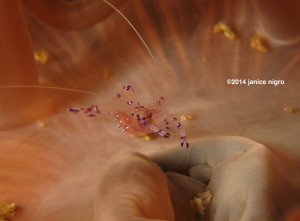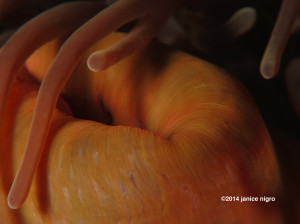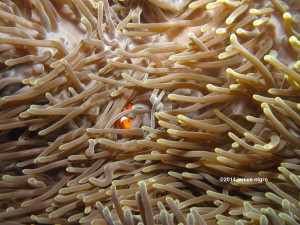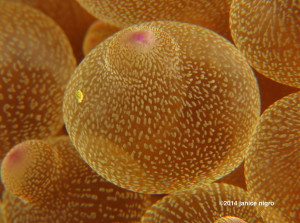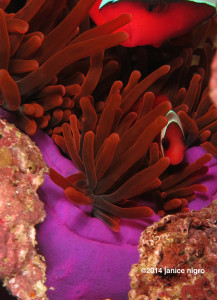Marine Life & Conservation
Is it anenome or anemone?
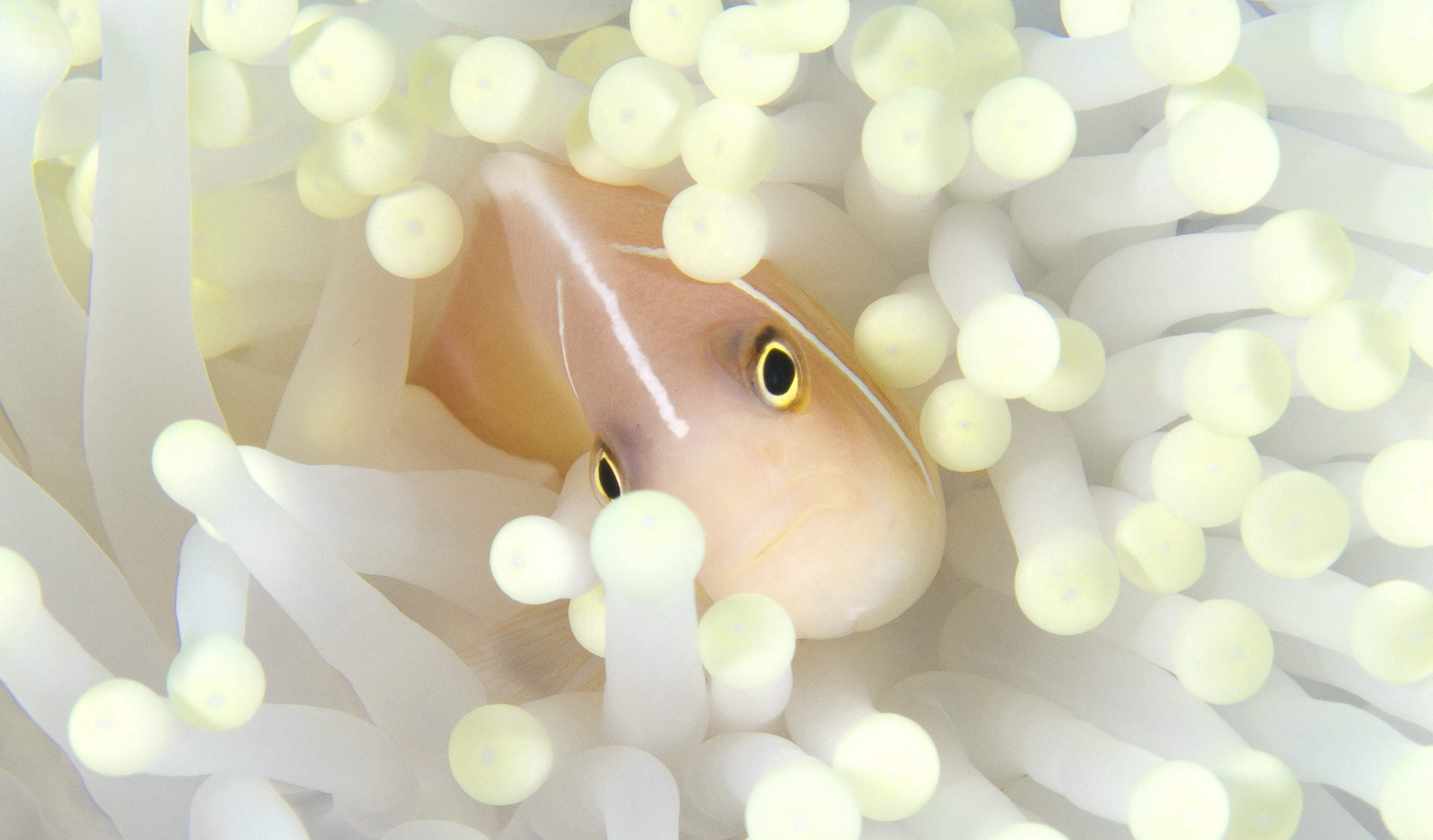
Plenty of tongue-twisting words for underwater creatures exist. Somehow mine for most of my life was simply anemone. Even as I write this, spell correct just corrected the word anemone. For me, it remains a conscious effort to say or write this word correctly. Eventually I realized my mistake but it was only after moving to Norway and while I was learning Norwegian. I am not exactly sure why I would have ever used the word before I started to scuba dive. Anemones were not necessarily in my conscience prior to diving, and it was in a pre-Finding Nemo era. Even then instead of calling him an anemonefish, most people just call him a clownfish, which he is also.
Anemone, however, is not the kind of word that comes up in casual conversation, nor are you going to learn it in language class, not ever. When you are trying to learn a new language, you will read anything to become proficient (even advertisements are suddenly interesting) but luckily, a Norwegian diving magazine exists. One of the ways that I would work on trying to learn Norwegian was to read the magazine. Honestly, I learned some useful words from “Dykking” and among them was anemone. It was then that I finally learned how to really say the word in English (which is easier to pronounce in Norwegian because of the syllable accent), and if you look at the name Nemo it is in fact a part of the right way to say the word. In my dictionary it would have been Neno, which of course makes no sense at all.
I really do not know how my obsession with anemones developed. I suppose they are easy targets for photography because you can readily identify them on your own as a new diver. And because of the anemonefish, although it is nearly impossible to take the fish photos as they constantly move. I like the fish, but I am more enamored of the anemone. Any kind of anemone. I will spot anemonefish hanging midwater and feel compelled to see the anemone over which they play. It must be entirely annoying to the dive guides who are working feverishly to find rare, micro-macroscopic creatures to show me. At the same time, I am easy to please. I am probably the only person who has ever shouted anemonefish (rather than whaleshark or manta) at the end of a dive on approach to the liveaboard boat.
Anyone who knows me, knows of my obsession. “Always looking at anemones,” a guide once said to me. But even he admitted that they are beautiful. I am constantly taking photos of them, and yet dive guides will still humor me by pointing out even more. Sometimes there are some simple scientific principles that I do like to test on them – for example, that color diminishes with depth-because anemones exhibit such natural variation in it. The strobe will change this depth effect, but by the time I reach the surface, I have often forgotten what their color was at depth! You can also test your skills at taking dramatic, abstract shots by photographing the mouth because of shadows and variation in color. Many of these photos end up not so innocent looking though, like a giant Georgia O’Keefe painting of a flower.
The underside scientifically referred to as the column (skirt in common use) of the anemone can be the biggest photographic surprise of all. Textures are fascinating, and colors defy your imagination. Sometimes they are even polka-dotted. Other times the column is wildly uncoordinated with the color of the tentacles. Purple column, red tentacles; yes, I saw this combination in Panglao Beach in the Philippines. How does this color combination evolve and who is this anemone trying to attract or distract?
But what do I really know about anemones? Not a whole lot apparently. I only recently discovered that they are related to coral and that like coral, they also have a symbiotic relationship with algae, one that gives them their color. I was shocked on a second cruise to Komodo within a two-month timeframe, to find a large proportion of “white anemones”. A cruise director informed me that they were not new anemones (because anemones are known to live a long time – as long as 100 years) but instead bleached anemones. Bleaching is the loss of symbiotic algae, which in addition to giving anemones color, produce nutrients for them. I am in complete awe of the array of tentacle colors (even pink, orange, and red), but the color of the column is animal pigment so it is all in the DNA of the anemone. Not only are anemones a mini-habitat to many different crabs, shrimp, and anemonefish, but a photosynthetic factory contributes to the support of all of it.
For all of that natural beauty though, an anemone is not exactly a hospitable habitat. Anemones are animals that sting. They harbor special miniature harpoon-like structures called nematocysts which inject poison/toxin into the flesh of prey, predators, and even other anemones where there are territorial disputes. The anemonefish, however, manages to live amongst the tentacles unharmed as do a variety of crustaceans. This ability is currently attributed to the mucus covering the skin of animals, and it is thought to prevent the triggering of the nematocysts. What magic ingredient within the mucous prevents discharge of the nematocyst remains a secret. Where the mucus comes from is even of controversy, probably because different species of anemonefish and anemones behave differently, but the protective mucus appears to originate from either the fish or the anemone. However, it might be a bit like superman and Planet Krypton because the mucus shield is not an all for one. In the right anemone, fish are protected, and in the wrong one, they can be just as vulnerable as another fish.
How anemonefish find an anemone to live in is another question with diverse answers. In fact, some anemonefish are less discriminating in terms of which type of anemone they can live in, whereas others have a distinct species that they inhabit. It seems that to some degree the fish are attracted by specific chemical signals originating from the anemone and less so by visual cues. This ability seems to be partly due to genetics, which is greatly enhanced if fertilized eggs are located within close proximity of their typical anemone home. It is believed then that the anemone makes factors that subtly influence the eggs predisposing them to responding to the cues and thus, finding a similar home when they grow up.
When you look at an anemone, you do not have to think too much about why the fish might want to live there. It is a beautiful house, you can easily hide in it, and if there is a real threat, the anemone can close itself around you. But anemones also look like they could just feel nice… as long as you are able to avoid the problem of engaging the nematocysts. Research actually shows that fish may engage in certain hedonistic behaviors. Anemonefish in a tank, when isolated from the anemone, for example, will bathe in the bubbles originating from the aerator. Real scientific measurements have been made, however. Cortisol, which is an indicator of stress, is actually found to be decreased in fish that are in contact with certain tactile sensations.
What exactly does an anemonefish do for the anemone? Apparently other people have had the same question (and fortunately got grant money to study it). I had zero ideas for the answer to this question so I did what we all do, I literally typed that question into Google.com. The first link that popped up was “Dancing Nemo: Clownfish wiggles do an anemone good”. No joke and who could resist reading an article with a title like that? This short paragraph led me to the real research article, which has the title “Anemonefish oxygenate their anemone hosts at night”. The bottom line is that the movement of the fish, which are especially active at night, keeps nutrient and gas flow (oxygen) constant over the anemone. Hmm, so maybe as an underwater photographer I may actually be helping the anemone because the fish move constantly when I try to take a photo.
Additional reasons have been proposed for why the fish is beneficial to the anemone as well. The anemone can snack on scraps from the fish, and it is even thought that nutrients from the fish waste are also good for the anemone. Furthermore, the fish protect the anemone from predators, that I would never have guessed, are the lovely butterfly fish. Apparently these fish are also impervious to the stinging by anemones, and without the anemonefish, anemones are quite vulnerable in the natural coral reef habitat. I have myself undergone direct attack by anemonefish (very scary), but I always thought they were protecting their eggs.
There are a thousand lessons to learn about relationships in nature just by looking at an anemone. And I am sure there are many others that we can not see. But this is why there has been so much research performed on them.
The fact that some very violent stuff is taking place within anemones does not change my opinion about them. Perhaps, their beauty is also viewed by other fish, and it is one of their ways to attract prey. It seems like that would be enough to attract me to an anemone, but maybe I was just an anenomefish in another life…
What burning question do you have about symbiotic relationships of sealife???
Blogs
Invitation from The Ocean Cleanup for San Francisco port call

6 years ago, The Ocean Cleanup set sail for the Great Pacific Garbage Patch with one goal: to develop the technology to be able to relegate the patch to the history books. On 6 September 2024, The Ocean Cleanup fleet returns to San Francisco bringing with it System 03 to announce the next phase of the cleanup of the Great Pacific Garbage Patch and to offer you a chance to view our cleanup system up-close and personal.
We look forward to seeing you there.
To confirm your presence, please RSVP to press@theoceancleanup.com
PROGRAM
Join The Ocean Cleanup as our two iconic ships and the extraction System 03 return to San Francisco, 6 years and over 100 extractions after we set sail, to create and validate the technology needed to rid the oceans of plastic.
Our founder and CEO, Boyan Slat, will announce the next steps for the cleanup of the Great Pacific Garbage Patch. Giving you a chance to view our cleanup system and the plastic extracted.
Hear important news on what’s next in the mission of The Ocean Cleanup as it seeks to make its mission of ridding the world’s oceans of plastic an achievable and realistic goal.
Interviews and vessel tours are available on request.
PRACTICALITIES
Date: September 6, 2024
Press conference: 12 pm (noon)
Location: The Exploratorium (Google Maps)
Pier 15 (Embarcadero at Green Street), San Francisco, CA
Parking: Visit The Exploratorium’s website for details.
RSVP: press@theoceancleanup.com
Video & photo material from several viewing spots around the bay
We look forward to seeing you there!
ABOUT THE OCEAN CLEANUP
The Ocean Cleanup is an international non-profit that develops and scales technologies to rid the world’s oceans of plastic. They aim to achieve this goal through a dual strategy: intercepting in rivers to stop the flow and cleaning up what has already accumulated in the ocean. For the latter, The Ocean Cleanup develops and deploys large-scale systems to efficiently concentrate the plastic for periodic removal. This plastic is tracked and traced to certify claims of origin when recycling it into new products. To curb the tide via rivers, The Ocean Cleanup has developed Interceptor™ Solutions to halt and extract riverine plastic before it reaches the ocean. As of June 2024, the non-profit has collected over 12 million kilograms (26.4 million pounds) of plastic from aquatic ecosystems around the world. Founded in 2013 by Boyan Slat, The Ocean Cleanup now employs a broadly multi-disciplined team of approximately 140. The foundation is headquartered in Rotterdam, the Netherlands, and opened its first regional office in Kuala Lumpur, Malaysia, in 2023.
Find out more about The Ocean Cleanup at www.theoceancleanup.com.
Marine Life & Conservation
SHARK MONTH ARRIVES AT ROYAL WILLIAM YARD, PLYMOUTH

A shark has been spotted approaching Royal William Yard in Plymouth, much to the surprise of swimmers, paddleboarders and onlookers.
With its distinctive dorsal fin cutting through the water, the sizeable shark swam along the coastline, before turning to head inland towards Firestone Arch at Royal William Yard. The appearance drew a crowd, who were captivated for more than an hour by the unusual sight – and it was all caught on video.
The shark is one of many expected sightings at Royal William Yard over the coming weeks… because today marks the start of Shark Month!
In reality, the ‘shark’ spotted along the Plymouth shoreline was actually a custom-made model, created by the team at Royal William Yard and sailed underwater by Caroline Robertson‑Brown from the Shark Trust, who donned scuba diving gear for the occasion.
The stunt took place to launch Shark Month in style and draw attention to the work of the leading international conservation charity, which is based in Britain’s Ocean City. Spectators were reassured that the water was safe and many entered into the spirit of the performance, swimming or sailing alongside the shark.
Shark Month will take place across Royal William Yard throughout July and will feature an extravaganza of art, entertainment and advocacy for everyone to enjoy. The packed programme of events starts with an art exhibition and ends with a trip on paddleboards with shark experts – with everything from a shark quiz to a Jaws screening in between.
Paul Cox, CEO of the Shark Trust, said: “There are often assumptions and misconceptions when it comes to sharks. This was certainly the case with the shark spotted at Royal William Yard! While the British coastline is home to many species of shark, this was not one of them. However, we’re thrilled it caught people’s attention, because seeing a shark is a special and memorable moment. That is precisely why we want to celebrate these incredible creatures, highlight the need for conservation, and ask for help to safeguard their future.”
For more information about Shark Month at Royal William Yard, visit the Shark Trust Website.
Images and video: Jay Stone
-

 Blogs2 months ago
Blogs2 months agoDiving With… Nico, Ocean Earth Travels, Indonesia
-

 News1 month ago
News1 month agoMurex Bangka Announce New Oceanfront Cottages & Beachfront Dining
-

 Blogs2 months ago
Blogs2 months agoA new idea in freediving from RAID
-

 Marine Life & Conservation1 month ago
Marine Life & Conservation1 month agoIceland issue millionaire whale hunter a licence to murder 128 vulnerable fin whales
-

 Marine Life & Conservation2 months ago
Marine Life & Conservation2 months agoThe Shark Trust Great Shark Snapshot is back
-

 News3 months ago
News3 months agoCharting New Waters; NovoScuba Goes Global with the Launch of their Revolutionary Dive Training Agency!
-

 Gear News1 month ago
Gear News1 month agoNew Suunto Ocean – a dive computer and GPS sports watch in one for adventures below and above the surface
-

 Marine Life & Conservation Blogs2 months ago
Marine Life & Conservation Blogs2 months agoBook Review: Plankton


